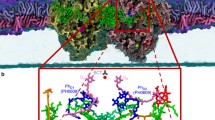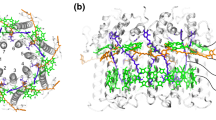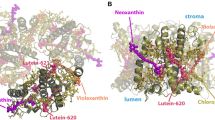Abstract
Photoinduced electron transfer reactions play an important role in the primary step of the biological photosynthesis process. In an attempt to understand better the mechanism of the charge separation organic donor-acceptor molecules containing porphyrins and quinones were designed as photosynthesis models. In order to study the structure dependence of the photoinduced electron transfer twofold and fourfold bridged porphyrin-quinone systems with increasing donor-acceptor distance were synthesized (Figure 1) [1, 2, 3]. It was assumed that in these molecules the porphyrin and quinone should be linked in a rigid and well-defined orientation. To verify this assumption the conformational behavior of these systems was studied by high-temperature MD simulations in combination with conformational analysis of selected minimized structures [4, 5].
Similar content being viewed by others
Author information
Authors and Affiliations
Corresponding author
Rights and permissions
About this article
Cite this article
Frank, M., Peraus, K. & Staab, H.A. Exploring the Conformational Behavior of Rigid Porphyrin-Quinone Systems by High-Temperature MD Simulations and Temperature-Dependent 1H-NMR Experiments. J Mol Model 2, 383–385 (1996). https://doi.org/10.1007/s0089460020383
Received:
Accepted:
Published:
Issue Date:
DOI: https://doi.org/10.1007/s0089460020383




